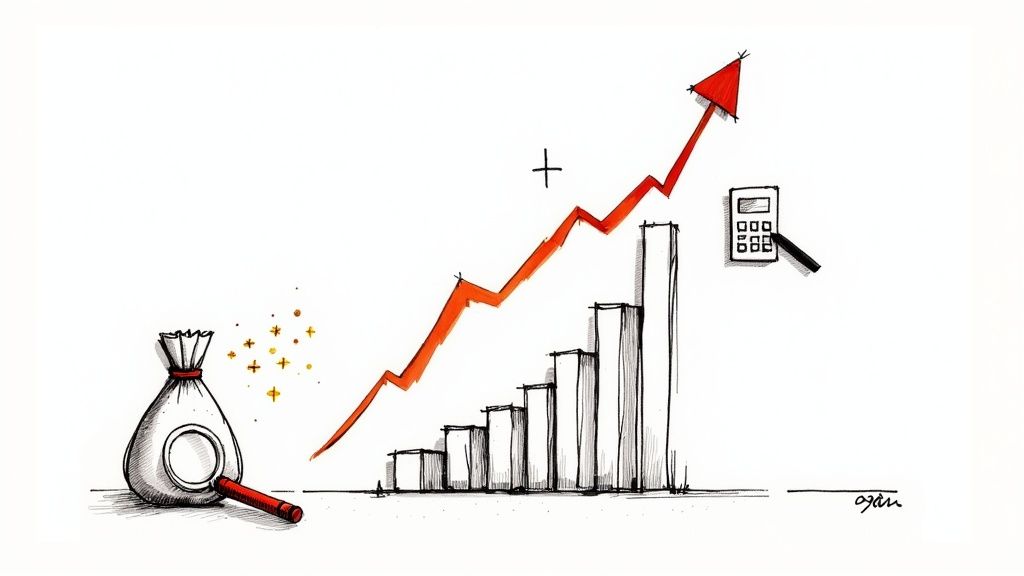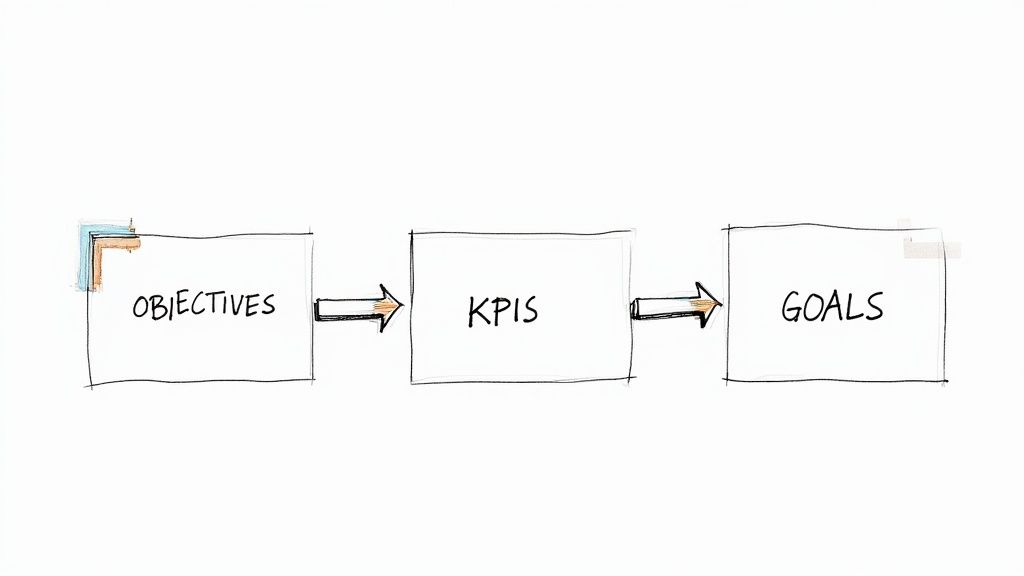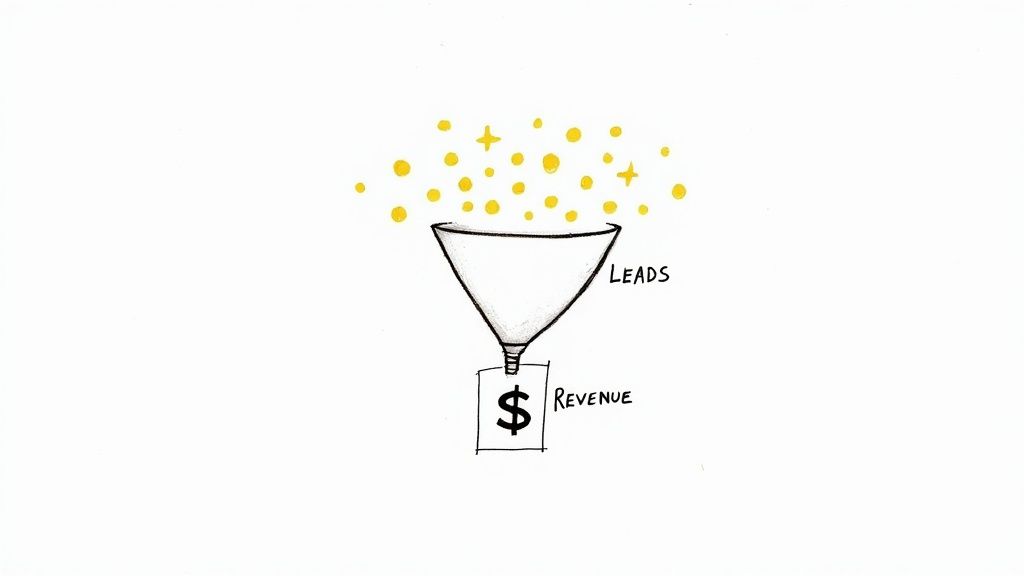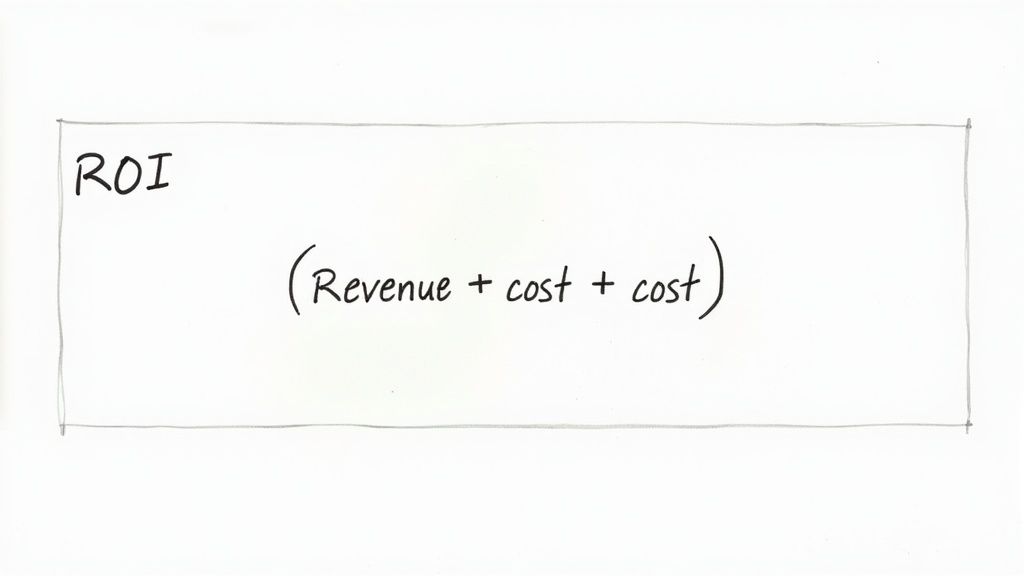
how to measure marketing roi
How to Measure Marketing ROI The Right Way
Posted on Oct 6, 2025

To calculate your marketing return on investment (ROI), the formula is pretty straightforward: (Revenue - Investment) / Investment. Multiply that by 100, and you've got your ROI as a percentage.
Simple, right? This little calculation shows you exactly how much profit you're making for every single dollar you put into your marketing. Honestly, getting a handle on this metric is non-negotiable if you want to prove your value.
Why You Need to Get Serious About Marketing ROI
Let's be real—calculating marketing ROI often feels like that one task that keeps getting pushed to the bottom of the to-do list. But in a world where every dollar in the budget is under a microscope, it’s the single most important skill a marketer can have.
The days of justifying your budget with flashy campaigns and vanity metrics like "likes" or "impressions" are long gone. Today, the C-suite wants proof, not promises. They need to see a clear, undeniable line connecting what you do every day to the company's bottom line. This is where knowing how to measure marketing ROI for real growth becomes your secret weapon.
From Cost Center to Growth Engine
When you can walk into a meeting and confidently present solid ROI data, you completely change the conversation about marketing. Your department stops being seen as a "cost center"—that necessary but expensive part of the business—and starts being recognized as a predictable engine for growth.
That shift is powerful. Suddenly, you can:
- Justify your strategies. Hard ROI numbers are the ultimate proof that your initiatives are working. It silences the skeptics and builds incredible trust with leadership.
- Secure bigger budgets. Data-backed proposals are infinitely more persuasive. When you can show a 5:1 return on your last campaign, asking for more resources isn't an expense request—it's an investment conversation.
- Earn a strategic voice. Marketers who can speak the language of revenue and profit get a seat at the table. You start influencing key business decisions that go way beyond just running the next campaign.
This isn't just a hunch; it's a massive industry trend. A whopping 83% of marketing leaders now say that demonstrating ROI is a top priority. On top of that, 64% of companies are basing their marketing budgets directly on past performance.
By mastering these calculations, you’re not just keeping up; you’re positioning yourself as a forward-thinking leader. This data-first mindset is also a cornerstone of effective revenue management, tying your efforts directly to the financial health of the business.
The ability to articulate ROI is what separates a tactical marketer from a strategic business leader. It’s the bridge between your daily work and the financial health of the entire organization.
Ultimately, getting serious about ROI means you can make smarter, more confident decisions that drive real, measurable results.
Essential Metrics for Your ROI Calculation
Before you can plug numbers into the formula, you need to know what you're tracking. Getting these metrics right is the foundation of an accurate ROI calculation.
Here's a quick breakdown of the key data points you'll need to gather.
| Metric | Definition | Example |
|---|---|---|
| Gross Profit | The total revenue generated from your marketing campaign minus the cost of goods sold (COGS). | You generated $50,000 in sales. The products sold cost $15,000 to produce. Your Gross Profit is $35,000. |
| Marketing Investment | The total cost of your marketing campaign. This includes ad spend, software, agency fees, and creative costs. | You spent $5,000 on Facebook ads, $1,000 on a landing page tool, and $1,500 on a freelance copywriter. Your total investment is $7,500. |
| Net Profit | The final profit after all marketing investments have been subtracted from the gross profit. | Using the examples above, your Net Profit is $35,000 (Gross Profit) - $7,500 (Investment) = $27,500. |
Having these figures clearly defined and tracked makes the final ROI calculation a simple matter of plugging them into the formula we started with. It removes the guesswork and gives you a number you can stand behind.
Gathering the Right Data Before You Calculate Anything

There's an old saying in data science: "garbage in, garbage out." Nowhere is this more brutally true than when trying to measure marketing ROI. Before you even think about plugging numbers into a formula, your entire effort hinges on the quality and accuracy of the data you're collecting.
Think of it like this: if the foundation of your house is cracked, everything you build on top of it is doomed to fail. It doesn't matter how fancy the ROI formula is if it's based on bad data. A misconfigured tracking code or a poorly defined conversion goal can make your final number completely useless.
The only way to get a real, trustworthy ROI figure is to build a rock-solid data collection process from the ground up. This means ensuring every metric is clean, reliable, and directly tied to an actual business outcome.
First, Nail Down Your Conversion Goals
You can't measure success if you haven't defined what "success" looks like. The first step is to get crystal clear on what a "conversion" actually means for your business. Vague goals just lead to vague results, making it impossible to calculate a meaningful ROI.
For an e-commerce brand, this is usually pretty straightforward: a completed purchase. But for a SaaS company, the customer journey is often more complex, with several important conversion points along the way.
For E-commerce: Tracking is direct. You need to make sure your platform, whether it's Shopify or WooCommerce, is correctly passing all the critical transaction data—like order value and product details—into your analytics.
For SaaS/B2B: The conversion might be a demo request, a free trial sign-up, or even a whitepaper download. The trick here is that each of these leads has a potential value that you need to assign based on historical data. For example, if you know that 1 in 10 demo requests eventually becomes a customer with an average contract value of $5,000, then you can value each demo request at $500.
Setting up these specific goals in a tool like Google Analytics is non-negotiable. It's the only way to draw a straight line from your campaign activity to a tangible business result.
Your ROI calculation is only as strong as your weakest data point. Take the time to meticulously set up and verify your tracking before you invest a single dollar into a new campaign. This proactive step prevents costly misinterpretations later on.
Next, Meticulously Track Every Single Cost
Just as important as tracking your returns is tracking every dollar you spend. This is where so many marketers get it wrong. They only count the obvious ad spend, which paints a skewed, overly optimistic picture of their return.
To get an honest ROI calculation, you have to account for the total investment. No exceptions.
Your total investment needs to include:
- Direct Ad Spend: The money paid directly to platforms like Google Ads, Meta, or LinkedIn.
- Tool and Software Costs: All those subscription fees for analytics tools, email marketing platforms, landing page builders, and more.
- Creative and Production Costs: Any money spent on freelance designers, copywriters, or video editors.
- Agency or Consultant Fees: The cost of any third-party partners helping with the campaign.
The best practice is to consolidate all these expenses into a single spreadsheet or project management tool for each campaign. This creates a "single source of truth" for your investment and stops costs from slipping through the cracks. This level of detail is what separates a wild guess from a truly accurate measure of your marketing ROI.
The Core Formulas That Actually Matter

Let's get into the math. Don't worry, you don't need a finance degree to figure out your marketing ROI. It really boils down to one classic formula that cuts right to the chase. For a deeper dive into the nuts and bolts, this guide on how to calculate marketing ROI is a great resource.
The simplest and most direct way to get a handle on your return is with this equation:
ROI = [(Sales Growth - Marketing Investment) / Marketing Investment] x 100
This formula spits out a percentage that tells you exactly what you got back for every dollar you put in. If it's a positive number, you're in the black. Negative? You lost money on that one.
Putting the Classic Formula into Practice
So, how does this look in the real world?
Picture a vacation rental company trying to drive more direct bookings. They decide to run a targeted ad campaign on Meta (that's Facebook and Instagram) for a month.
Here's a quick look at their numbers:
- Marketing Investment: They put $5,000 into ad spend and paid a freelance designer $1,500 for the creative. That's a total investment of $6,500.
- Sales Growth: The campaign pulled in $25,000 in direct booking revenue.
Time to plug those numbers into our formula:
ROI = [($25,000 - $6,500) / $6,500] x 100 = 284%
A 284% ROI is a massive win. It’s clear proof that the campaign was a huge success, bringing in $2.84 in profit for every $1 they spent. This is the kind of hard data that makes budget meetings a lot less stressful and shows your strategy is on the right track. It also gives you valuable intel for what to do next, like using conversion rate optimization techniques on the campaign's landing page to squeeze out even better results.
Going Beyond a Single Campaign with Customer Lifetime Value
The basic ROI formula is perfect for a snapshot of a specific campaign, but it has a blind spot: it doesn't account for the long-term value of a customer. For businesses that rely on repeat customers—like a vacation rental where a guest might re-book every summer—this is a huge deal.
This is where Customer Lifetime Value (LTV) becomes your best friend. LTV estimates the total amount of money you can expect to earn from a single customer over their entire relationship with you. When you factor it in, you get a much truer sense of your marketing's real impact.
To figure out LTV, you just need a few numbers:
- Average Purchase Value (APV): How much a customer spends on average per transaction.
- Purchase Frequency (PF): How often they buy from you in a set period, like a year.
- Customer Lifespan (CL): The average amount of time they stick around as a customer.
The formula is simple: LTV = APV x PF x CL
By shifting your focus from a single transaction to the entire customer relationship, LTV transforms your ROI calculation. It reveals that a campaign with a modest initial return might actually be incredibly profitable over the long run.
Let’s go back to our vacation rental brand. They look at their data and find that the average booking is $1,000 (APV). Guests typically book once a year (PF), and they tend to come back for about 3 years (CL).
LTV = $1,000 x 1 x 3 = $3,000
Now, think about their ad campaign again. If it brought in 25 new customers, the total value generated wasn't just the initial $25,000. It’s actually $75,000 (25 customers x $3,000 LTV). Suddenly, the long-term ROI of that campaign looks absolutely astronomical, justifying the investment in winning loyal, repeat guests.
How to Measure ROI on Tricky Marketing Channels
Not every marketing channel plays by the same, neat rules. It's one thing to track a click from a paid ad directly to a sale—that's clean, simple math. But what about channels like content marketing, SEO, and social media? Their impact is often more subtle, playing out over the long term.
Measuring their ROI requires a different mindset. You have to look beyond the immediate transaction.

These channels are often the very first touchpoint a customer has with your brand. A genuinely helpful blog post or an engaging social media update might not trigger a sale that day, but it builds the kind of trust and awareness that pays off weeks, or even months, down the line. If you ignore their contribution, you're working with a dangerously incomplete picture of what’s actually driving your growth.
Measuring Content Marketing and SEO ROI
Content marketing and SEO are the ultimate long game. Seriously. You could publish a fantastic blog post today, and it might not generate any meaningful traffic for six months. But once it starts ranking, that single piece of content can become a consistent source of leads and revenue for years with very little ongoing effort.
So, how do you actually measure the return on these efforts? You have to shift your focus from direct, immediate sales to the value of the organic traffic and leads they generate over time.
Here’s a practical way to think about it:
- Put a Price Tag on an Organic Lead: First, figure out what an organic lead is worth to you. Let's say 1 in 20 organic leads eventually becomes a customer, and your average customer value is $2,000. Simple math tells you each organic lead is worth $100.
- Connect Conversions to Content: Next, jump into your analytics. See how many of those valuable leads came from specific blog posts or other content pieces.
- Look at the Long-Term Payoff: If a blog post costs you $500 to create but starts generating 10 leads per month (worth $1,000), it pays for itself in just over two weeks. After that, it's pure profit, working for you 24/7.
Don’t fall into the trap of judging your content’s success in the first 30 days. True SEO and content ROI is measured in quarters and years, not weeks. The goal is to build a lasting asset, not a temporary spike.
Demystifying Social Media ROI
Social media is another one of those channels where direct, last-click attribution will lead you astray. Sure, some sales will come directly from a social post, but its real power often lies in building your brand and influencing decisions over time. The data backs this up: while 81% of consumers say social media influences their purchasing decisions, only about 30% of marketers feel they can accurately measure its ROI.
To get a clearer picture of your social media ROI, you can dive into some insightful statistics about its impact. The key is to stop looking only at direct sales and start blending quantitative and qualitative metrics.
Here are a few things I always look at:
- Track Assisted Conversions: In Google Analytics, check out the "Assisted Conversions" report. This will show you how many times your social channels were part of the customer journey, even if they weren't the final click.
- Monitor Engagement on High-Value Posts: Are posts about specific products or services driving more comments, shares, and saves? That's a strong indicator of interest that can translate into future sales.
- Use Unique Discount Codes: This one is super straightforward but effective. Create channel-specific promo codes (like "INSTA20") to directly track sales that come from platforms like Instagram.
This blended approach helps you see the whole story of how social media contributes to your revenue, both directly and indirectly.
Figuring out which metrics matter most depends heavily on the channel itself. What works for email won't necessarily apply to SEO. Here’s a quick breakdown to help you compare.
Comparing ROI Measurement Across Marketing Channels
| Channel | Primary Goal | Key ROI Metrics | Common Challenges |
|---|---|---|---|
| Email Marketing | Nurture leads, drive repeat purchases | Open rate, click-through rate, conversion rate from emails, unsubscribe rate | List fatigue, deliverability issues, accurately attributing sales from long nurture sequences |
| SEO | Increase organic visibility, attract qualified traffic | Organic traffic growth, keyword rankings, conversion rate of organic visitors, lead value | Long time-to-value, algorithm updates, difficulty attributing revenue to specific SEO actions |
| Paid Search (PPC) | Generate immediate leads and sales | Cost per click (CPC), cost per acquisition (CPA), conversion rate, ad spend ROI | Rising ad costs, click fraud, intense competition for high-value keywords |
| Social Media | Build brand awareness, engage community, influence purchases | Engagement rate, reach, assisted conversions, referral traffic, sales via promo codes | Proving direct revenue impact, measuring brand sentiment, long and complex conversion paths |
As you can see, each channel has its own set of goals and hurdles. The trick is to align your measurement strategy with what you’re trying to achieve on that specific platform, rather than trying to apply a one-size-fits-all ROI formula.
Tossing Out the Old ROI Playbook for AI-Powered Accuracy

If you're still calculating marketing ROI with just a spreadsheet and a basic calculator, I have some bad news for you. That world is long gone. The entire analytics landscape is being reshaped by artificial intelligence and a huge, necessary shift toward data privacy.
To get a real handle on your performance, you have to look past the simple formulas and start using tools that give you a much sharper, more honest picture.
Manual calculations and outdated attribution models—I'm looking at you, last-click—just can't keep up anymore. They completely miss the messy, winding path a modern customer takes. We know a single purchase can be nudged along by dozens of touchpoints across different channels over several weeks. This is exactly where AI-powered platforms change the game.
Moving Beyond Simplistic Attribution
AI doesn’t just credit the last thing a customer clicked. Instead, it sifts through thousands of data points to figure out how every single blog post, ad, and email actually contributed to a sale. It can spot patterns a human would never see, giving you a crystal-clear understanding of which channels are your true workhorses.
This is having a massive impact. AI and machine learning are now helping businesses forecast campaign results with 67% greater accuracy than old-school methods. By 2025, it's expected that nearly 30% of companies worldwide will rely on AI-driven analytics to get a better grip on their ROI.
This lets you make much smarter budget decisions. You can finally shift resources to the channels that genuinely drive revenue, not just the ones that happen to be at the finish line. If you're looking for the right platform, our guide on the best AI marketing tools is a great place to start your search.
Adapting to a Cookieless Future
The other massive change is the phase-out of third-party cookies. This is forcing every marketer I know to completely rethink how they track behavior and measure what's working. The path forward really comes down to two things: predictive modeling and a laser focus on your first-party data.
- Predictive Modeling: AI can take the data you do have—like website behavior and email engagement—to forecast future actions and attribute conversions without needing invasive trackers.
- First-Party Data: The information you collect directly from your audience, like email lists and CRM data, has become pure gold. It's the new foundation for building reliable ROI models in a privacy-first world.
By leaning into AI and treating your own customer data as the valuable asset it is, you're not just getting compliant with new privacy rules. You're building a more resilient, accurate system for measuring marketing ROI that will give you a serious leg up on the competition.
Your Top Questions About Marketing ROI, Answered
Even when you have the formulas down and the data in front of you, a few practical questions always pop up. It's one thing to know the theory, another to apply it in the real world. Let's dig into some of the most common sticking points I hear from marketers.
What Is a Good Marketing ROI, Anyway?
This is the million-dollar question, isn't it? The honest answer is: it depends. A "good" marketing ROI isn't some universal number. It shifts dramatically based on your industry, profit margins, and the very nature of your business.
That said, a common benchmark people toss around is a 5:1 ratio. This means you're generating $5 in revenue for every $1 spent. For most businesses, that's a solid, healthy return. An ROI of 10:1 or higher is usually seen as exceptional.
But context is everything.
- A high-margin software company might be perfectly happy with a 3:1 ROI on a campaign that locks in long-term subscribers. The lifetime value makes it worth it.
- An e-commerce store with razor-thin margins, however, might need to hit that 10:1 mark just to cover its costs and pocket a decent profit.
My advice? Stop chasing vague industry averages. The best thing you can do is establish your own internal benchmarks. Dig into your profit margins and look at historical campaign data to figure out what a "good" ROI truly means for the financial health of your business.
How Often Should I Be Checking My ROI?
The right cadence for measuring ROI depends entirely on the channel and the length of your sales cycle. A one-size-fits-all schedule just doesn't cut it here.
For fast-moving digital channels like paid search or social media ads, you should be in there checking performance weekly, if not daily. These platforms are built for quick optimization. If you wait too long to check in, you could be burning through your budget on ads that simply aren't working.
On the flip side, for long-haul strategies like SEO or content marketing, a monthly or quarterly review makes a lot more sense. These channels build momentum and value over time. Checking your ROI too often can be misleading and might tempt you to kill a strategy right before it starts bearing fruit. The key is to sync your reporting schedule with your business planning cycles.
How on Earth Do I Measure ROI for Brand Awareness Campaigns?
This is one of the trickiest questions out there. Brand awareness campaigns are tough because they rarely lead to an immediate sale. The whole point is to build familiarity and trust over the long run, not to get a click and a conversion today.
So, instead of trying to tie these campaigns directly to revenue, you need to focus on proxy metrics. These are indicators that show a clear lift in your brand's visibility and serve as strong evidence that your campaign is having an impact.
A few key proxy metrics to keep an eye on include:
- Direct Website Traffic: Are more people typing your URL directly into their browser? That's a great sign.
- Branded Search Volume: Is there a spike in the number of people searching for your brand name on Google?
- Social Media Engagement: Look for growth in your followers, mentions, and shares across your social channels.
By tracking the trends in these metrics and lining them up with your campaign's timeline, you can build a powerful case for its value, even without a direct sales-to-spend number.
Ready to stop guessing and start growing? hostAI uses advanced AI to enhance your online presence, automate marketing, and drive more direct bookings for your short-term rental business. Discover how hostAI can double your direct revenue.